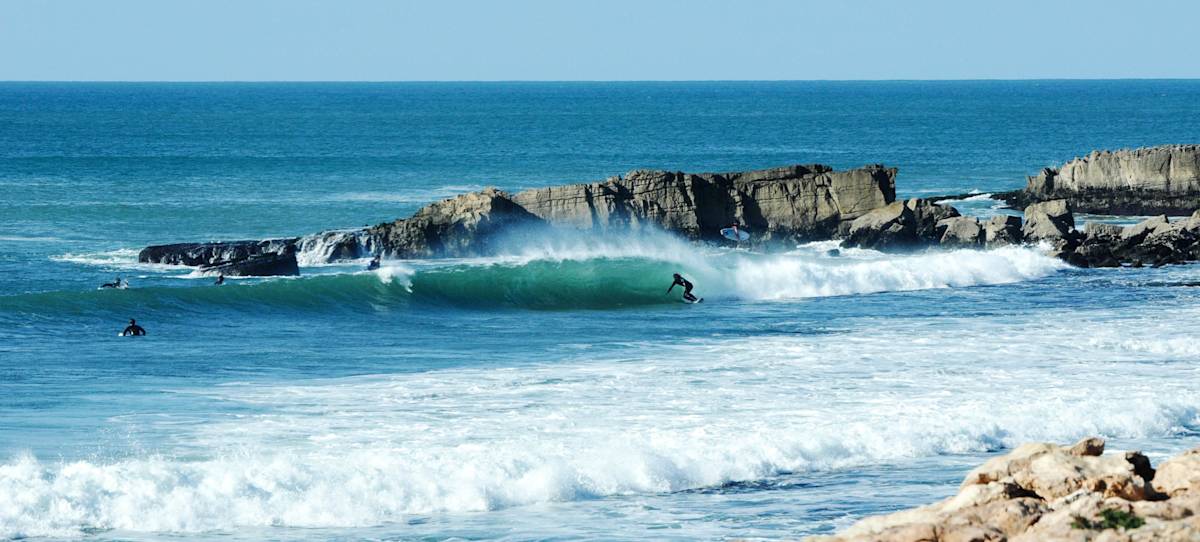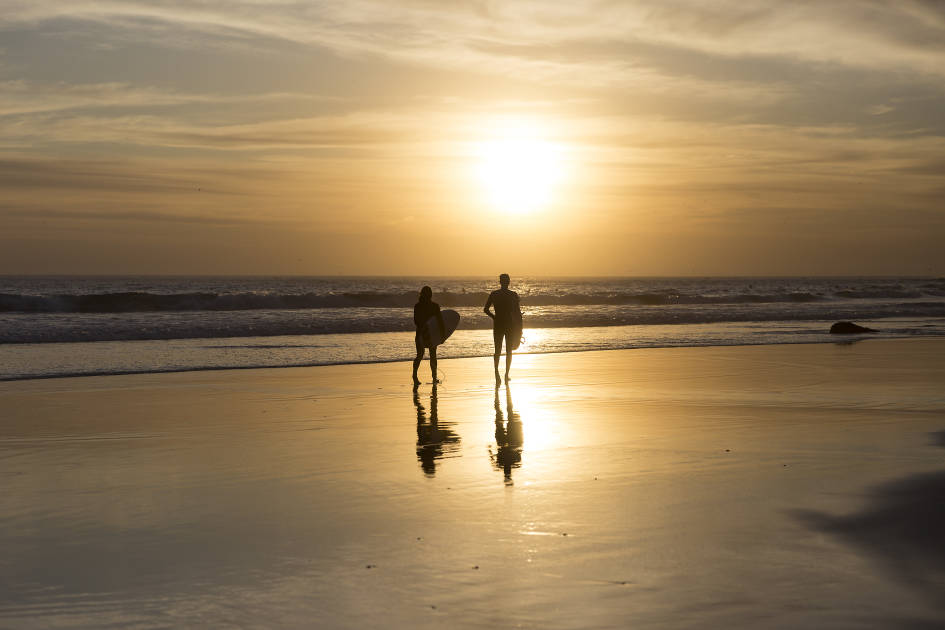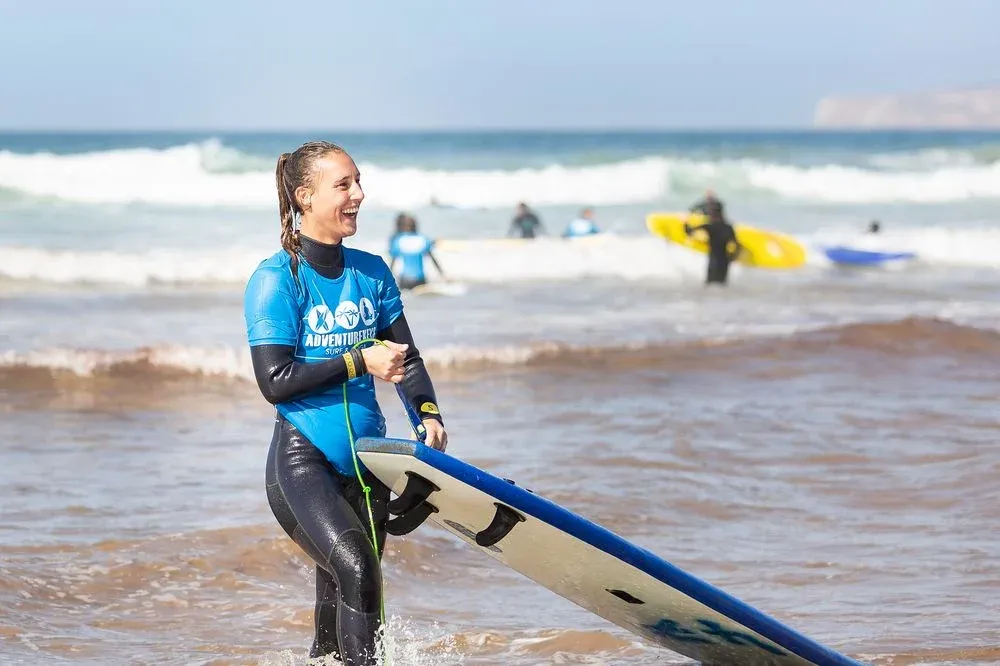
It’s hard to explain the thrill of catching and riding a wave. For a start, there’s the sense of achievement. But then there’s the feeling itself: you’re balancing on a board on top of the water, being pushed along by the powerful force of the waves. It’s utterly exhilarating, like gliding and flying all at once.
I first tried surfing last year, in Morocco. We stayed in a riad in the sleepy fishing village of Tamraght; each day we visited the beaches of Taghazout, a surfing resort nearby. Our mornings began with lessons on the sand. We learned how to jump up onto the board and paddle to catch a wave. How to 'pop up', moving from our bellies to a standing crouch, and the correct stance to adopt so we wouldn’t overbalance. Then we jumped into the waves to try it for ourselves.
Of course, trying to stand up and balance was much harder in the water than on Terra Firma. But it was also much more fun. There’s a childlike joy to zipping over the waves, and even to falling off your board; especially after you’ve done it a couple of times and realised it doesn’t hurt.

At the beginning of my trip, I was a complete novice. By the end of my trip, I was still a novice - but one who’d managed to stand up on a surf board and ride a few waves. Here are a few things I wish I knew before trying surfing for the first time.
It’s Far More Physical Than You Think

I was surprised how tired I felt after my first day of surfing, and how sore I was the next day. It’s a far more physically active sport than I’d anticipated. You’re paddling long distances to catch waves. Once you’ve ridden ashore (or fallen off your board) you have to walk back out to sea, pushing against the resistance of the water. Then, you have to pull yourself up onto the board, over and over again.
When I’m running, I’m very aware that I’m exercising. I can feel my heart rate increase; I concentrate on breathing so I don’t tire myself out. But when you surf, you’re immersed in the sights, smells, sounds and movements of the waves. You’re not counting your steps, or the miles. Instead you’re focused on catching waves, standing up, wiping out. It’s such an immersive, exhilarating experience that you forget how physically demanding it is.
Make sure you take breaks - head back to shore for a snack or to drink some water. To combat the post-surf soreness, I took a couple of early morning yoga classes. The stretches helped loosen my muscles and energise me for the day ahead.

The Most Important Lesson is About Timing

The most important lesson for a beginner surfer to learn is about timing. You go out beyond the break, point your board to the shore and wait for a wave. Obviously, the ocean is full of waves but you want to catch one at the exact right moment - after it’s risen and before it breaks.
Catch a wave too soon and it won’t have any power. Chances are it’s going to roll right on past you. Catch a wave too late and your board is going to nosedive into the ocean. You need to get a ‘green wave’, right at the peak of its power, harnessing its energy with your board and riding it for as far as you can.

You also need the right sized wave. If it’s too small, it won’t have enough energy to drive you forward. If you’re a beginner, some waves might be too large, exceeding your confidence and skill level. In fact, when we first started learning, we practiced in the whitewater, where the waves had already broken and were moving leisurely towards the shore.
Popping up is also a question of timing. I was often too slow, so by the time I was crouched in the correct position on the board, the wave had lost its power. Occasionally I’d overcorrect and stand up too fast, which often meant I wiped out (that means ‘fall over’ in surfer speak, and I did it a lot). But towards the end of my trip I started timing it right. When I did, I was flying.
Even in A Short Time, it Builds Resilience

Try and stand up. Fall. Get back up. Try. Fall, fail. Get back up. Over and over and over. It’s easy to draw parallels between surfing and whatever else is going on in your life at the moment. A surfer, Hayley Lawrence, who’s also a single mum of three, once told me that surfing had improved her resilience.
“Learning to surf has been slow progress, but I can see a difference in my personality,” she told me. “Before I was an underconfident single parent struggling with my kids, and now I feel a lot stronger and more confident in where I am in my life. I've learned a lot mentally as well as physically.”
When I learned to surf, I was scared of large waves - which stems from being knocked over and held under by one as a child. Over the next few days, I confronted this fear. At one point I caught a wave too late and my board flew into the air as the wave broke over me, forcing me under the water. It wasn’t as terrifying as I remembered, and I managed to stay calm. This experience showed me that sometimes the things you’re afraid of aren't as scary as you think.
Bring a Decent Sunscreen - and Warm Clothes

The most important thing to take with you to the beach is sunscreen. Even though most of your body will be hidden under a wetsuit, your face will be exposed to the sun’s rays. Get yourself a high SPF, water-resistant sunscreen. However, some sun creams contain harmful chemicals like oxybenzone and octinoxate, which have been linked to coral bleaching when they come off into the water. Instead, choose an ocean friendly sunscreen, which contains minerals such as zinc oxide and titanium dioxide.
When I surfed in Morocco in April, we were treated to bright, sunny weather. But it can get windy in Taghazout, making the temperature feel lower. I also hadn’t anticipated that after a day in the water I’d be cold, even wearing a wetsuit. If I return to Morocco at the same time of year, I’d bring a fleece jacket or hoodie with me, to warm up after a surf session.
There’s More to Your Surf Trip Than Surfing

You’ll spend hours of each day in the water. But eventually you have to get out and dry off, and then you’ll have the afternoon and evening free to explore. When you start planning a surf trip, I’d suggest finding a location with more to offer than surfable waves. I chose Morocco as a surfing destination because I love sunshine and good food. While I was there in April I got my fill of both, gorging myself on homemade cous cous and tagines.
There was plenty to look at on the beaches of Taghazout too. The other surfers, all of different abilities (and with varying degrees of sunburn). Men walking up and down the beach selling bracelets, doughnuts and tkhlita tea (made with a mix of fresh herbs including mint, rosemary and wormwood). Grumpy camels, on the beach to give tourists a ride.

In the evenings, we explored the winding lanes of Tamraght. We browsed the carpet shop, bought pastries from the bakery and made friends with the stray cats lying in patches of sun.
One night, I watched the sun set on the beach. As it sank below the horizon, I heard the muezzin’s call to prayer spill out of the speakers of a nearby mosque. People began arriving on the beach with picnics to break their fast. It was a far cry from the bustle of Taghazout; two different lives unfolding on the sand, against the rhythmic backdrop of the waves.
Inspired? Learn to Surf in Morocco in a Weekend with us, or the longer Learn to Surf in Morocco in a Week.



